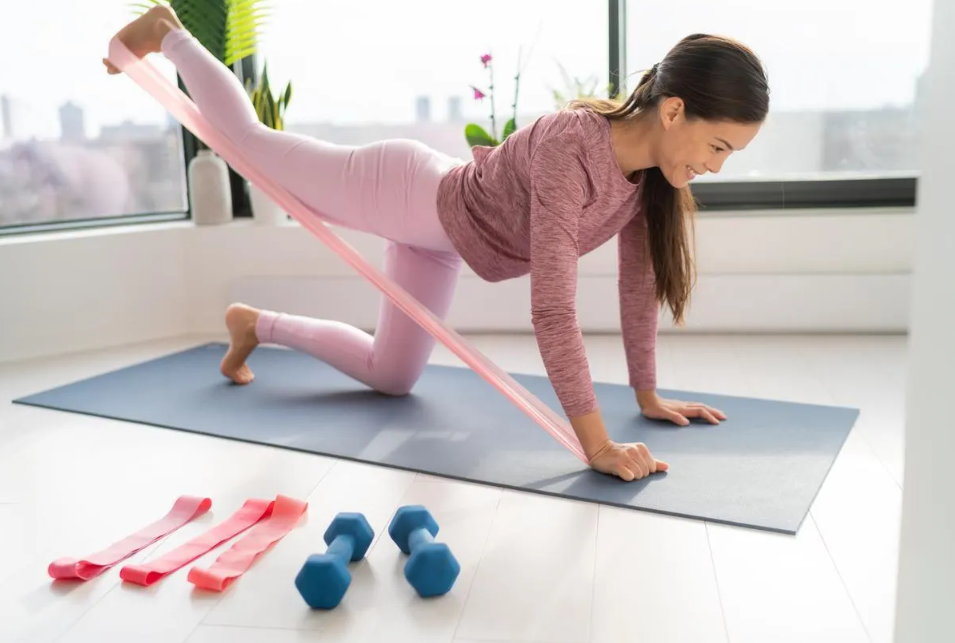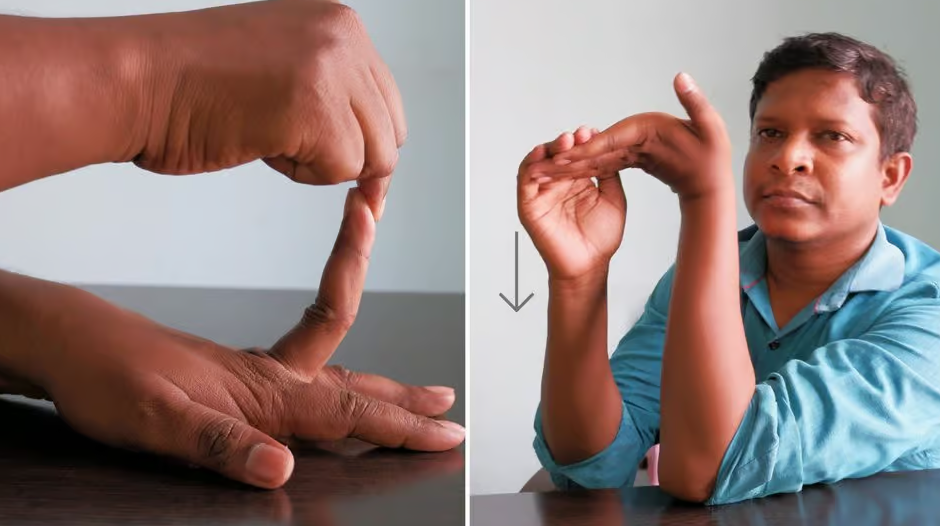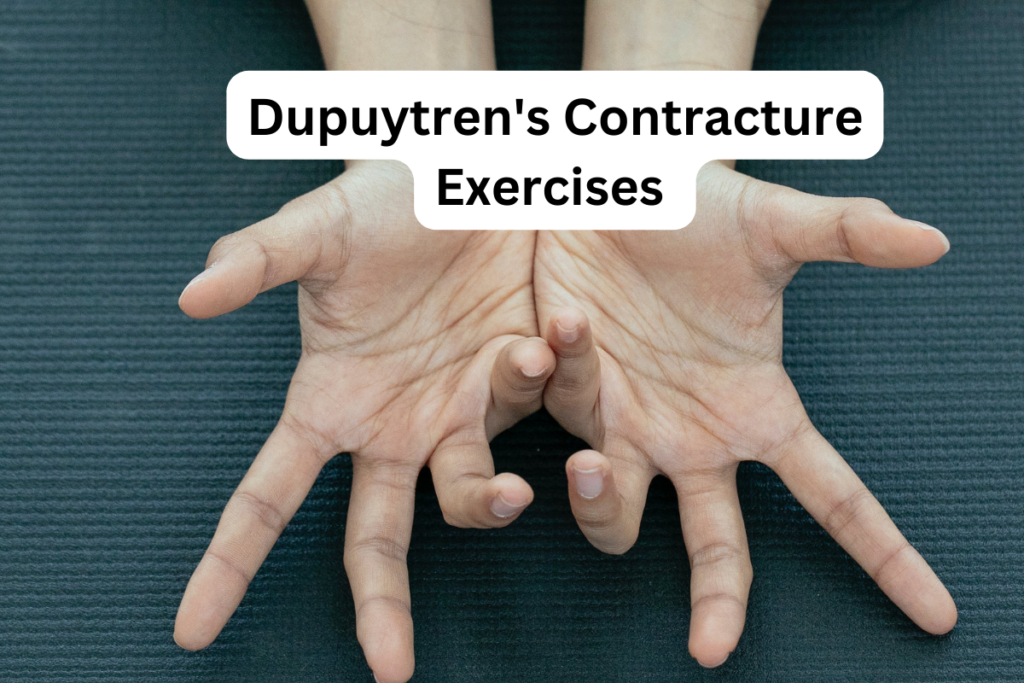Dupuytren’s contracture, a progressive condition that causes thickening and tightening of the palmar fascia (palm tissue), can significantly impact hand function and daily activities. While surgery remains a definitive treatment option in advanced cases, exercises play a crucial role in managing Effective Dupuytren’s Contracture Exercises and maintaining hand mobility.
This comprehensive guide delves into the world of Dupuytren’s contracture exercises, equipping you with the knowledge and tools to combat this hand condition. We’ll explore various stretches, strengthening techniques, and helpful tips to maximize the effectiveness of your exercise routine.
Understanding Dupuytren’s Contracture
Before diving into exercises, let’s gain a clear understanding of Dupuytren’s contracture. This condition arises from the buildup of collagen, a protein that forms scar tissue within the palmar fascia. This overproduction of collagen leads to cords and nodules, gradually pulling fingers towards the palm, causing contracture (bending).
While the exact cause of Dupuytren’s contracture remains unknown, genetic predisposition, age (often affecting individuals over 50), and certain medical conditions like diabetes are known risk factors.
Benefits of Exercises for Dupuytren’s Contracture

While exercises cannot cure Dupuytren’s contracture, they offer a multitude of benefits in managing the condition and improving hand function:
- Maintain and improve finger range of motion: Stretching exercises help lengthen the tightened palmar fascia, preventing further contracture and preserving finger movement.
- Reduce pain and stiffness: Gentle stretches and movements can improve blood flow and circulation, alleviating pain and stiffness associated with the condition.
- Increase hand strength and grip: Strengthening exercises help maintain muscle function and grip strength, allowing you to perform daily tasks with greater ease.
- Slow disease progression: Regular exercise may potentially slow the progression of Dupuytren’s contracture, delaying the need for surgery.
- Improve overall hand function and quality of life: By maintaining flexibility, strength, and pain-free movement, exercises can significantly enhance your daily life and activities.
Types of Exercises for Dupuytren’s Contracture
Now, let’s explore the specific exercises you can incorporate into your routine to manage Dupuytren’s contracture:
Stretches
Stretching forms the cornerstone of managing Dupuytren’s contracture. These gentle, sustained stretches aim to elongate the palmar fascia and improve finger extension:
- Finger Extension Stretch: Place your palm flat on a table, fingertips facing downwards. Gently use your other hand to pull each finger back, stretching the palm. Hold for 30 seconds and repeat 10 times for each finger.
- Tabletop Stretch: Place your hand flat on a table, fingers spread apart. Gently press down on the back of each finger, pushing them towards the table. Hold for 30 seconds and repeat 10 times.
- Towel Stretch: Wrap a towel around your affected fingers. Gently pull the towel away from your hand, stretching the fingers back. Hold for 30 seconds and repeat 10 times.
Strengthening Exercises
While maintaining flexibility is crucial, strengthening exercises also play a vital role in managing Dupuytren’s contracture. These exercises help maintain muscle function and grip strength:
- Ball Squeeze: Squeeze a soft rubber ball for several repetitions, gradually increasing the ball’s firmness as your strength improves.
- Finger Lifts: Place your hand flat on a table. Raise each finger individually against the table surface, hold for a few seconds, and then lower. Repeat 10 times for each finger.
- Making a Fist: Gently clench your hand into a fist, hold it for a few seconds, and then release. Repeat 10-15 times.
Advanced Techniques

While the basic stretches and strengthening exercises offer a solid foundation, you can elevate your Dupuytren’s contracture management routine by incorporating advanced techniques and personalization:
Targeted Stretching
- Finger Spread with Splint: Wear a finger splint that gently stretches your affected fingers overnight. This sustained stretch can be particularly effective for improving range of motion in the morning.
- Silicone Finger Cots: These gel-filled cots provide mild pressure and traction during stretches, potentially enhancing their effectiveness.
- Assisted Stretching: If reaching your fingers due to contracture is difficult, use a strap or loop to gently pull your fingers back and assist with the stretch.
Strengthening Variations
- Resistance Band Exercises: Use resistance bands of varying thicknesses to add difficulty to your finger lifts and other strengthening exercises. This progressive overload helps build muscle strength over time.
- Putty Exercises: Squeeze and mold therapeutic putty with different resistances to work on finger and hand musculature dynamically.
- Weight-bearing Exercises: Carry light weights (like water bottles) while performing finger lifts and other exercises to further challenge your muscles.
Functional Exercises
Incorporate exercises that mimic everyday activities to improve hand function and dexterity:
- Buttoning and Zipping: Practice buttoning and zipping with your affected hand to regain fine motor skills.
- Picking Up Objects: Pick up objects of different sizes and shapes to improve grip strength and coordination.
- Playing an Instrument: Playing a musical instrument, even for a short time each day, can be a fun and effective way to exercise your hand muscles and coordination.
Tailoring Your Routine

Consult your doctor or a hand therapist to personalize your exercise program based on the severity of your Dupuytren’s contracture, your individual needs, and any co-existing conditions. They can help you:
- Determine the specific exercises most beneficial for your stage of the condition.
- Set realistic goals and track your progress over time.
- Modify exercises as needed to ensure comfort and safety.
Additional Tips for Success:
- Warm up before and cool down after your exercise routine.
- Focus on controlled movements and proper form.
- Breathe deeply and maintain a positive attitude during your exercises.
- Celebrate your progress, no matter how small.
- Be patient and consistent with your routine for long-term benefits.
Remember, managing Dupuytren’s contract is a journey, not a destination. By incorporating a variety of effective exercises, listening to your body, and seeking professional guidance when needed, you can empower yourself to maintain hand function, reduce pain, and improve your quality of life.
Living with Dupuytren’s Contracture
While managing Dupuytren’s contract requires dedication and effort, it’s important to remember that you’re not alone. Support groups and online communities can offer invaluable resources, encouragement, and shared experiences. Consider connecting with others who understand your journey and can offer support and tips.
Furthermore, exploring alternative therapies like acupuncture or ultrasound therapy may be beneficial for some individuals. Discuss these options with your doctor to determine if they might complement your exercise routine and overall management plan.
Remember, Dupuytren’s contracture doesn’t have to define you. By taking an active role in managing your condition through exercise, self-care, and seeking professional support, you can reclaim control and maintain a positive outlook on your hand health and overall well-being.
Resources and References
- American Academy of Orthopaedic Surgeons: https://www.aaos.org/videos/video-detail-page/26692__Videos
- Mayo Clinic: https://newsnetwork.mayoclinic.org/discussion/mayo-clinic-q-and-a-dupuytrens-contracture/
- National Institutes of Health: https://www.ncbi.nlm.nih.gov/books/NBK526074/
- Dupuytren’s Contracture Support Group: https://dupuytrens.org/
- Arthritis Foundation: https://dupuytrens.org/category/dupuytren-foundation/
FAQs – Dupuytren’s Contracture Exercises
How often should I do Dupuytren’s contracture exercises?
Aim to perform your exercises several times a day, ideally for 10-15 minutes each session. Consistency is key, so try to find a schedule that works for you and stick to it. If you’re starting, begin with gentle stretches and gradually increase the frequency and intensity of your exercises as your strength and flexibility improve.
What are some good exercises for Dupuytren’s contracture?
There are many effective exercises for Dupuytren’s contracture, targeting both stretching and strengthening. Here are a few examples:
- Finger extension stretch: Place your palm flat on a table with your fingers pointing down. Gently use your other hand to pull each finger back, stretching the palm. Hold for 30 seconds and repeat 10 times for each finger.

Image Credit: Physiosunit - Tabletop stretch: Place your hand flat on a table with your fingers spread apart. Gently press down on the back of each finger, pushing them towards the table. Hold for 30 seconds and repeat 10 times.

Image Credit: rebalancetoronto - Towel stretch: Wrap a towel around your affected fingers. Gently pull the towel away from your hand, stretching the fingers back. Hold for 30 seconds and repeat 10 times.

Image Credit: orthobethesda - Ball squeeze: Squeeze a soft rubber ball for several repetitions, gradually increasing the ball’s firmness as your strength improves.

Image Credit: physiosunit - Finger lifts: Place your hand flat on a table. Raise each finger individually against the table surface, hold for a few seconds, and then lower. Repeat 10 times for each finger.

Image Credit: dmoose
Remember, it’s always best to consult with your doctor or a hand therapist for personalized exercise recommendations based on your specific needs and the severity of your Dupuytren’s contracture.
Will exercises cure Dupuytren’s contracture?
No, exercises cannot cure Dupuytren’s contracture. The condition is caused by a buildup of collagen in the palmar fascia, and unfortunately, exercises cannot reverse this process. However, exercises can play a vital role in managing the symptoms of Dupuytren’s contracture and preventing further progression. By maintaining flexibility and strength in your hands, you can significantly improve your hand function and quality of life.
What are some signs that I may be overdoing my exercises?
It’s important to listen to your body and avoid overdoing your exercises. Some signs that you may be pushing yourself too hard include:
- Pain: If you experience pain during or after your exercises, stop and consult your doctor or therapist.
- Increased stiffness: If your hands feel stiffer after exercising, it could be a sign of inflammation. Take a break and give your hands a rest.
- Redness or swelling: If you notice any redness or swelling in your hands, it could be a sign of an injury. Stop exercising and see your doctor.
Remember, it’s better to err on the side of caution and take breaks when needed. You don’t want to injure yourself and set back your progress.
Can I use heat or massage to help with Dupuytren’s contracture exercises?
Yes, heat and massage can be helpful adjuncts to your exercise routine. Applying heat to your hands before exercising can improve blood flow and prepare your muscles for stretching.
Gentle massage can also help loosen the palmar fascia and reduce pain. However, it’s important to avoid aggressive massage or applying heat for too long, as this could worsen your symptoms.







